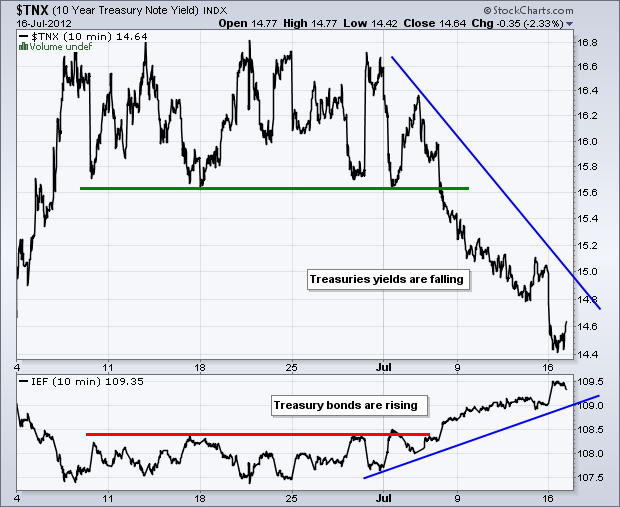Selling pressure hit the stock market after a weak retail sales report, but the major index ETFs managed to firm and finish with small losses. With another key economic report coming in below expectations, investors turned their attention to the prospects of more quantitative easing. Fed chairman Ben Bernanke testifies before congress over the next two days and stocks are hoping that he will throw them a bone. Treasury bonds are certainly reacting to the weak economic reports as the 10-year Treasury Yield ($TNX) broke support in early July and the 7-10 year T-Bond ETF (IEF) broke resistance. These trends are negative for stocks and make the major index ETFs vulnerable in the coming days. A Bernanke let down could hit stocks and commodities quite hard.
The S&P 500 ETF (SPY) remains in a medium-term uptrend since early June and a short-term uptrend since Friday's breakout. SPY broke falling channel resistance with a surge above 135 and this breakout is holding. The ETF consolidated just above 135 and I am now marking first support at 134.4. A move below this level would negate the breakout and provide the first sign of weakness. Key support remains at 132.5 and RSI support at 40.

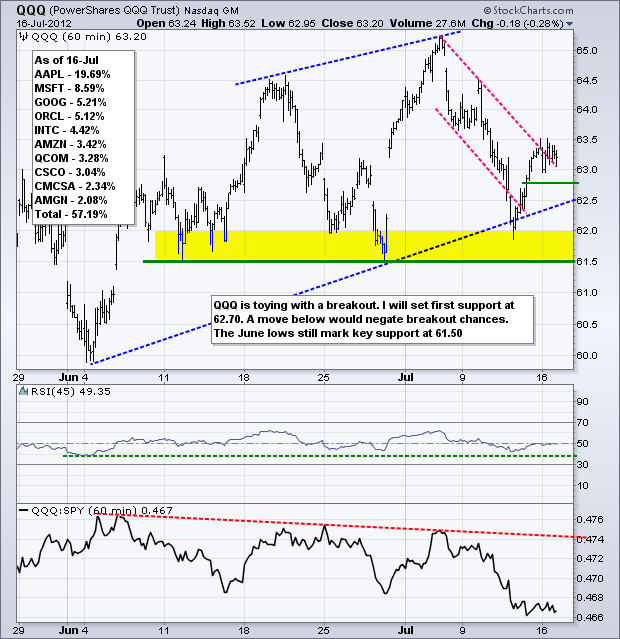
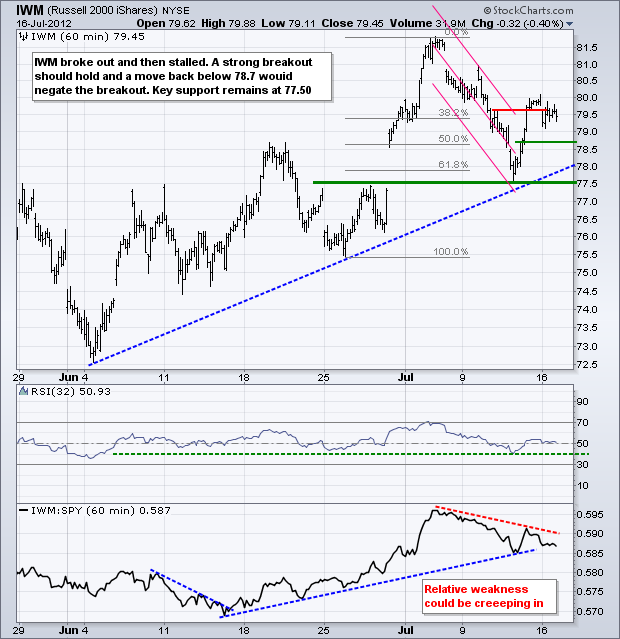
**************************************************************************
No change. Even though SPY broke out and the finance sector led, this advance and breakout are suspect as long as treasuries remain strong. Treasuries are not undervalued and offer a negative real return. Strength, therefore, can only be attributed to fear, such as fear of economic weakness, worse-than-expected earnings and continuing problems in Europe. The 20+ Year T-Bond ETF (TLT) broke out on Monday and held its breakout throughout the week. Only a move back below broken resistance would suggest a failed breakout. For now, TLT remains in bull mode and I consider this bearish for stocks.
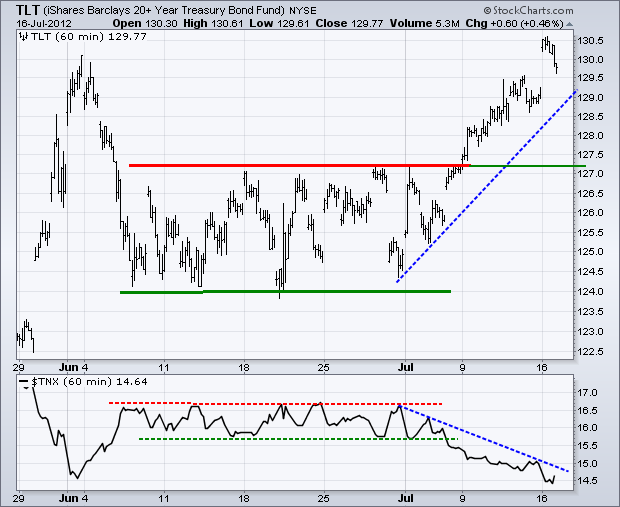
**************************************************************************
The Dollar retreated as the US Dollar Fund (UUP) declined towards broken resistance in the 22.80 area. The overall trend for the Dollar remains up as long as this breakout holds. RSI moved into the 40-50 zone and this area might offer support. The greenback will also tune into Bernanke's testimony before congress. More quantitative easing would be Dollar bearish.
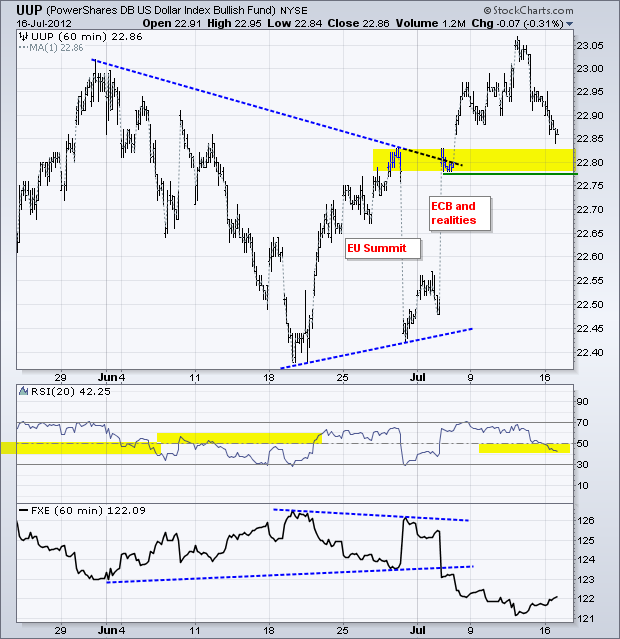
**************************************************************************
Commodities will also be listening intently for signs of quantitative easing, which would be bullish for oil et al. The US Oil Fund (USO) broke falling wedge resistance and this breakout is holding. Key support is set at 31.50 on the price chart and momentum support is set at 40 (RSI).

**************************************************************************
Gold will also look for more signs of quantitative easing. Anything that hurts the Dollar and pumps more money into the system would be bullish for gold. The Gold SPDR (GLD) broke falling wedge resistance on Friday and then consolidated with a high-tight flag. A break above 155 would signal a continuation higher and another challenge to bigger resistance. Failure to follow through and a move below 153 would put the bears back in the short-term driver's seat. Note that the bears control the bigger trend, which has been down since August.
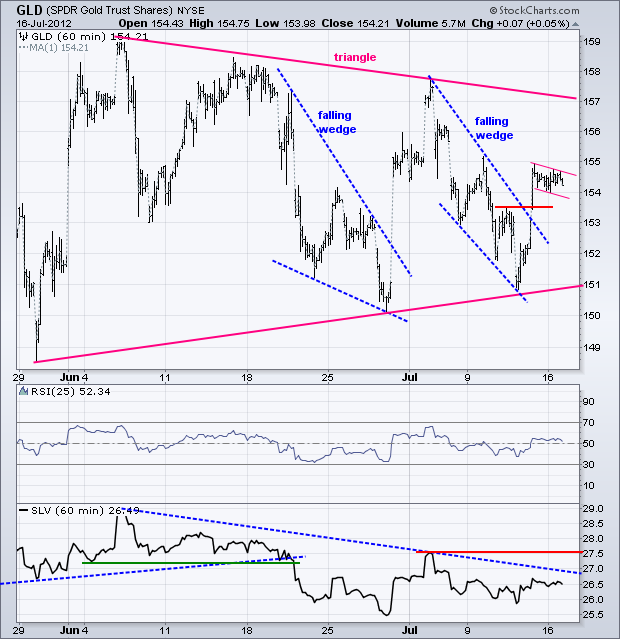
**************************************************************************
Key Reports and Events:
Tue - Jul 17 - 08:30 - Consumer Price Index (CPI)
Tue - Jul 17 - 09:15 - Industrial Production
Tue - Jul 17 - 10:00 - NAHB Housing Market Index
Wed - Jul 18 - 07:00 - MBA Mortgage Index
Wed - Jul 18 - 08:30 - Housing Starts/Building Permits
Wed - Jul 18 - 10:30 - Oil Inventories
Wed - Jul 18 - 14:00 - Fed's Beige Book
Thu - Jul 19 - 08:30 - Jobless Claims
Thu - Jul 19 - 10:00 - Existing Home Sales
Thu - Jul 19 - 10:00 - Philadelphia Fed
Thu - Jul 19 - 10:00 - Leading Indicators
Charts of Interest: Tuesday and Thursday
This commentary and charts-of-interest are designed to stimulate thinking. This analysis is not a recommendation to buy, sell, hold or sell short any security (stock ETF or otherwise). We all need to think for ourselves when it comes to trading our own accounts. First, it is the only way to really learn. Second, we are the only ones responsible for our decisions. Think of these charts as food for further analysis. Before making a trade, it is important to have a plan. Plan the trade and trade the plan. Among other things, this includes setting a trigger level, a target area and a stop-loss level. It is also important to plan for three possible price movements: advance, decline or sideways. Have a plan for all three scenarios BEFORE making the trade. Consider possible holding times. And finally, look at overall market conditions and sector/industry performance.

